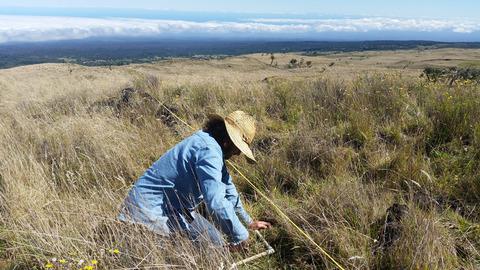当前位置:
X-MOL 学术
›
J. Appl. Ecol.
›
论文详情
Our official English website, www.x-mol.net, welcomes your feedback! (Note: you will need to create a separate account there.)
Moisture availability and ecological restoration limit fine fuels and modelled wildfire intensity following non-native ungulate removal in Hawaii
Journal of Applied Ecology ( IF 5.7 ) Pub Date : 2021-06-17 , DOI: 10.1111/1365-2664.13952 Timothy R. Zhu 1 , Creighton M. Litton 1 , Christian P. Giardina 2 , Clay Trauernicht 1
中文翻译:

在夏威夷去除非本地有蹄类动物后,水分可用性和生态恢复限制了精细燃料和模拟的野火强度
更新日期:2021-06-17
Journal of Applied Ecology ( IF 5.7 ) Pub Date : 2021-06-17 , DOI: 10.1111/1365-2664.13952 Timothy R. Zhu 1 , Creighton M. Litton 1 , Christian P. Giardina 2 , Clay Trauernicht 1
Affiliation

|
- The removal and exclusion of non-native ungulates for conservation of biodiversity is common globally, including on tropical Pacific Islands. However, the poorly quantified effects of ungulate exclusion on fuels and wildfire may represent an important conservation trade-off.
- We measured fuels (live and dead fuel loads, type, height and continuity) and modelled potential wildfire behaviour (flame height and rate of spread) inside and outside of 13 ungulate exclosures, three of which received active ecological restoration (e.g. planting of native shrubs and trees), across a 2,740 mm mean annual rainfall (MAR) gradient on the Island of Hawaii. Differences in fuel characteristics and modelled wildfire behaviour inside versus outside of ungulate exclosures were assessed using linear mixed effects analyses.
- Non-native ungulate removal, in general, increased fine fuel loading (average change ranged from −0.7 to 11.3 Mg/ha), shrub fuel loading (−0.1 to 5.6 Mg/ha) and modelled flame lengths (−0.2 to 1.9 m). Post-removal fine fuel loading and modelled flame lengths increased linearly and positively with moisture availability, by as much as 56% in the wettest sites. Dead fine fuels, a key driver of fire intensity and combustion rates, also increased with ungulate removal. Sites undergoing active ecological restoration exhibited reductions in fuel loading, with greater reductions over time since ungulate removal; by the 10th year following ungulate removal, fine fuel loading was reduced at restoration sites by 41%.
- Synthesis and applications. Dry and mesic environments where wildfire occurrence is more frequent are of particular concern following non-native ungulate removal, but with drought even typically wet environments can be at high risk of wildfire following ungulate removal. Given limited resources, managers in mesic and wet forests might focus first non-native ungulates in non-native grass-dominated areas that contribute disproportionately to wildfire spread and are adjacent to fenced higher value areas, while managers in dry to mesic areas might focus on removing non-native ungulates. Where possible, land managers in all situations should invest in long-term fuel management strategies such as active ecological restoration to reduce fuel loads and the occurrence and intensity of wildfires.
中文翻译:

在夏威夷去除非本地有蹄类动物后,水分可用性和生态恢复限制了精细燃料和模拟的野火强度
- 为保护生物多样性而移除和排除非本地有蹄类动物在全球范围内很普遍,包括在热带太平洋岛屿上。然而,排除有蹄类动物对燃料和野火的量化影响可能代表了一个重要的保护权衡。
- 我们测量了 13 个有蹄类动物围栏内外的燃料(活燃料和死燃料负荷、类型、高度和连续性)并模拟了潜在的野火行为(火焰高度和蔓延速度),其中三个获得了积极的生态恢复(例如种植本地灌木和树木),横跨夏威夷岛 2,740 毫米的年平均降雨量 (MAR) 梯度。使用线性混合效应分析评估了有蹄类动物围栏内部与外部的燃料特性和模拟野火行为的差异。
- 一般来说,去除非本地有蹄类动物会增加精细燃料负载(平均变化范围为 -0.7 至 11.3 毫克/公顷)、灌木燃料负载(-0.1 至 5.6 毫克/公顷)和模拟火焰长度(-0.2 至 1.9 m) . 去除后的精细燃料负载和模拟火焰长度随着水分可用性线性增加,在最潮湿的地方增加了 56%。死细燃料是火灾强度和燃烧率的关键驱动因素,也随着有蹄类动物的移除而增加。进行积极生态恢复的场地显示燃料负荷减少,自有蹄类动物移除以来随着时间的推移减少更多;到有蹄类动物移除后的第 10 年,修复地点的精细燃料负荷减少了 41%。
- 合成与应用。在移除非本地有蹄类动物后,野火发生更频繁的干燥和中等环境尤其令人担忧,但在干旱的情况下,即使是典型的潮湿环境在有蹄类动物移除后也有发生野火的高风险。鉴于资源有限,中湿森林的管理人员可能首先将非本地有蹄类动物集中在非本地草为主的地区,这些地区对野火蔓延的贡献不成比例,并且与围栏高价值区域相邻,而干旱到中湿地区的管理人员可能会专注于去除非本地有蹄类动物。在可能的情况下,所有情况下的土地管理者都应投资于长期的燃料管理策略,例如积极的生态恢复,以减少燃料负荷以及野火的发生和强度。


























 京公网安备 11010802027423号
京公网安备 11010802027423号